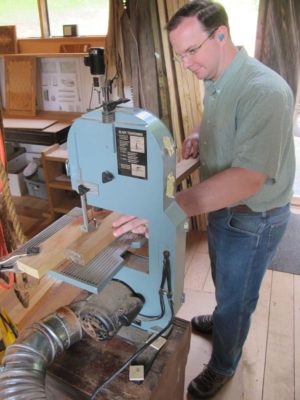
Recently I was corresponding with a reader who asked my opinion about bench top bandsaws, a preferred option for him because his career led to frequent moves. I answered him that I have two benchtop bandsaws I use frequently, one a 9-inch Delta bandsaw that must be close to forty years old by now, and a 10-in Rikon I bought about fifteen years ago from either Highland or Woodcraft, I honestly cannot remember. Each bandsaw has a critical role to play in my work, the Delta is my tool for sawing veneers for parquetry and the Rikon for pretty much everything else of modest size. (I also have a free standing Delta 14″ and a Taiwanese 14″ with a riser block for resawing.)
In the back-and-forth of our correspondence once I understood his situation I recommended he look into the Rikon.
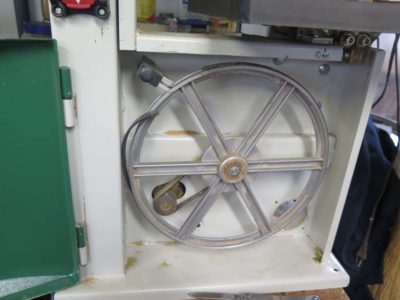
Some not-too-long-ago maintenance on the machine confirmed my overall impression formed several years ago that it is a superb tool. Last year during a workshop the saw broke a tire, and after setting it aside for the 9-inch Delta for the remaining days a new tire was on-hand and eventually I replaced the broken one.

Swapping out the tire was the easiest time for that task ever. After removing the retaining ring on the axel of the wheel and cleaning off the detritus of the tire I started the new tire at one point on the wheel then placed that section of the wheel in my Emmert metalwork vise and was able to install the new tire in approximately one minute.
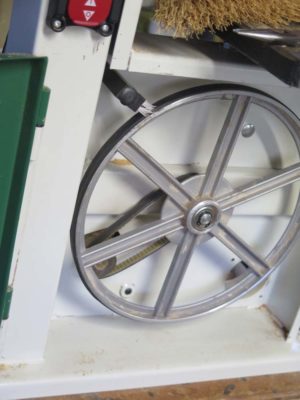
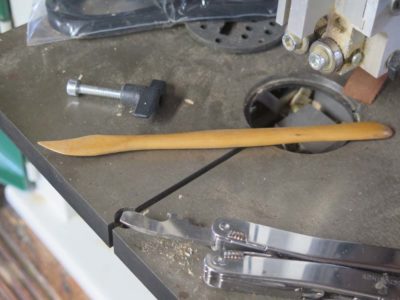
Since I had the wheel off I gave the lower section a through cleaning then did the same to the upper section including scraping the upper tire with a boxwood carving tool with a knife edge to remove the accreted crust but not cut into the tire, then put on a new blade and readjusted all the guides so that it ran perfectly. Unlike my other bandsaws I have found that the factory originals work just fine.
I know that in the coming decades this might be my only power machine (along with a drill press), and I am confident that the little Rikon will serve me well. Even now I cannot think of any recent project that it could not have completed. Perhaps not quite as fast as some ther machinery, but it would get the job done. I keep a variety of blades on hand to use whatever suits the task best, and find that a 3/8″ blade suits me 95% of the time.
I’ve have recently added a nice standard feature enhancing the machine’s utility immensely.
Stay tuned.
The other day I was listening for the umpteenth time to jazz pianist Keith Jarret’s “Koln (Cologne) Concert,” the renowned and best selling solo piano album of time, I believe in any genre. Jazz may or may not be your cup of tea, and improvisational solo piano is an acquired taste but I hope that someday you, too, will reach that plateau of sophisticated consciousness to appreciate this album as much as I do. (Do I really need to insert a sarcasm tag?) Admittedly, personal tastes cannot be accounted for sometimes, I mean I have a younger brother, perhaps my closest friend, who listens to country music. Country music! Oh, the horror. It is almost impossible to believe that we share either any nature or nurture, but there it is.

Album cover art courtesy of ECM Records, via Wikipedia.
And once while I was in high school listening to some avant-garde ensemble music on the stereo (Amon Duul? Univers Zero? Mahavishnu Orchestra?) my saintly church-organ-playing mother gently knocked on the bedroom door and stuck her head in. “Don,” she asked in genuine bewilderment, “are all of those folks playing the same song?” My Baptist preacher father and mother were petty strict about the music in the home, no vulgar lyrics for example, but were far more flexible on the music itself outside of that constraint. I will note they probably remained convinced that they’d brought home the wrong baby from the hospital. They only knew that I listened to both Gregorian chants and jazz, and that did not fit into any template.
Back to Keith Jarret and the Cologne Concert. The tale of the concert is a fascinating one. Jarret was emerging at the pinnacle of his prowess as a solo composer and performer after a decade in major ensembles and was embarking on his first major solo tour IIRC. Almost everything about the concert went wrong. He was exhausted from travel, didn’t even get a decent meal before the late-night Saturday concert, and the piano was an inferior, out-of-tune substitute for the concert Boesendorfer he had requested. He almost walked away from this steaming pile of circumstances but the impassioned pleas to continue from the promoter, a German teenager, persuaded him to have mercy on her and give a concert.
Despite, or more probably because of, the challenges — his exhaustion, the poor quality of the tool at his disposal (the upper and lower registers were essentially non-functional) — he drew on the unquenchable fire of creativity within him and sat down and began to play. Every note and combination of notes was being created uniquely in real time at that moment. The limitations he faced drove him to accomplish what is generally considered to be the most brilliant performance ever witnessed in the realm of improvisational jazz.
The parallels are unmistakable to me and for our tribe of creative artisans. I find that my interest in many projects depends on the difficulties inherent in them. I wonder how many of you are motivated by the same stew.
We might not have exactly the right tool or the right piece of wood.. We might be out of sorts. We might be tired or hungry or have a backache.
And sometimes in such moments we draw deep on the reservoir of creative genus we possess and magic happens at the workbench.
And sometimes in our shops we are all Keith Jarrett. a kid of Hungarian and Scots-Irish heritage from Allentown PA who set the world on fire that miserable evening in Cologne, Germany.
Go.
Create.
Magic.
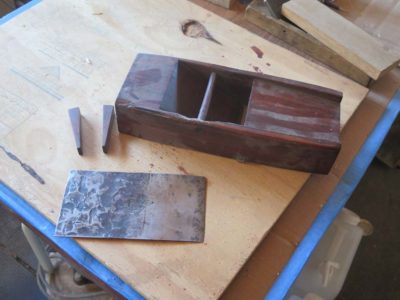
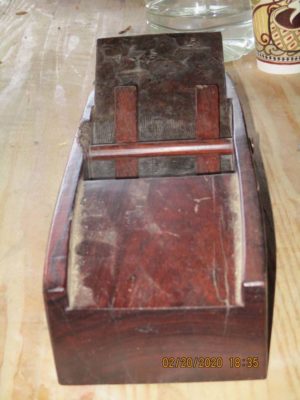
Somewhere along the way I picked up this gigantic solid rosewood plane of Eastern design and unknown genesis. I vaguely recall it being in a box of Japanese planes but since I turned 65 I am uncertain of this is a true memory or a false one. It does not really matter one way or the other.
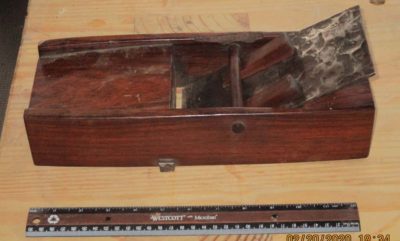
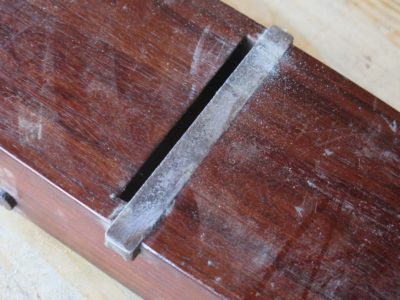
The coincidence of building my Japanese toolbox and Wilbur Pan’s presentation to DC-area woodworking guilds led me to pull it out again and give it a closer look-see. I sent the photos to Wilbur and he shares my inkling that this may be a Chinese plane, not Japanese.
The rosewood body is heavy enough that it would be like planing with a large brick. To say the very least if there were a sharp iron in the tool there would be precious little chatter.
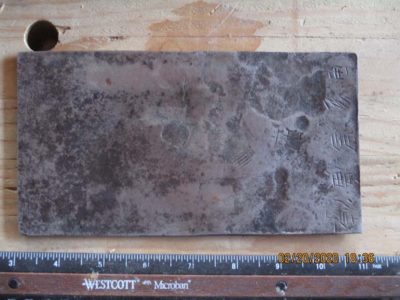
The piece of hammered steel(?) in the plane throat is only 1/8″ thick, probable too thin to be the cutting iron. But, it is not exactly configured for functioning as a chip breaker, either.
I asked a friend from China to interpret the pictograms but she was unable to decipher them so I have no idea what information is contained there.
I may just wind up buying a piece of 1/4″ tool steel 4″ x 6″ and grinding my own cutting iron, but am still scratching my head over this peculiar tool.
If you have any ideas about it let me know.
In the firmament of notable vintage tool events two pop up on my radar every year; the Martin Donnelly warehouse-cleaning auction in mid-July in central New York and the annual tool flea market and auction for the Potomac Antique Tools and Industries Association, or PATINA. The PATINA soiree is coming in less than a week, and if you are anywhere in the mid-Atlantic region it is well worth your effort to get there. You can find the details here.
I do not go as often as I used to since escaping Mordor, it’s only an hour north of DC but four hours from Shangri-La. I think I have been twice since moving to the hinterlands.
The outdoor tailgating starts at dawn and the weather is often (usually?) a challenge so make sure to dress appropriately. I cannot recall ever going when the weather was nice, but I’ve heard it is a theoretical possibility.
I have had amazing success at the tailgating, finding everything from derelict planes to be transformed into other tools, such as my parquetry shooting plane and the dovetail plane. I do not mind thrashing about with a $2 or $5 plane body for some wild scheme, but I would be hesitant to trash a $25 plane body. So I gather up a handful of the cheap vintage bodies to play with later on. I’ve also had great success in buying loose laminated old plane irons, and have been known to pick up my favorite model of old Stanley bench chisels for just a few dollars apiece.
By the time I’ve gone through the tailgating twice and made all my purchases there, the inside dealer’s sale is usually open and that is where I normally spend the rest of the day until I run out of money or energy.
Alas this year I will not be there as it is the first weekend of our famed Maple Festival and I am on duty there. These are the two weekends every year where our tiny county community of two thousand people are joined by tens of thousands of visitors to eat and drink all things maple syrupy. I’m not a huge maple flavor fan, but the buckwheat pancakes the size of trash can lids are to die for.

The new website for Handworks 2020 is now live and kicking. With virtually every maker of fine woodworking tools present as vendors and three adjacent venues and thousands of fellow comrades-in-tools it will be a memorable experience.
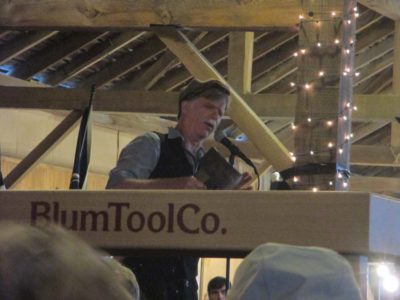
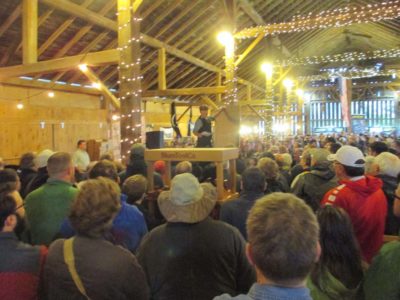
Once again Roy Underhill will be the Saturday morning speaker, always a great crowd pleaser.

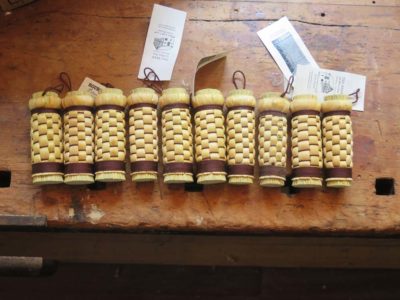
The Barn On White Run (that’s me!) will be present with loads of our polissoirs, waxes, polishes, and other items for your viewing and purchasing pleasure, and I will be giving demonstrations once an hour on using all of these items.
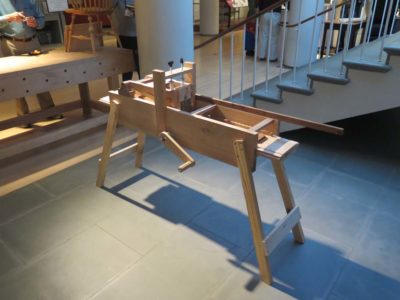
Plus my friend John will be joining me with the latest developments in ripple molding cutters.
As the days grow closer I’ll be blogging frequently bout the event and our participation and experiences there.
Make your plans to join us.
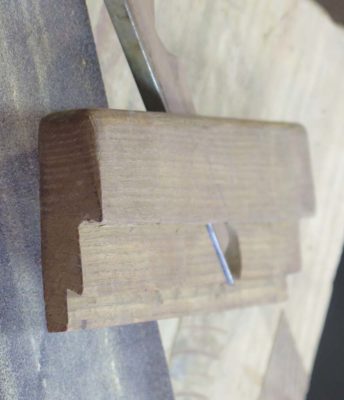
One of the accessories I want to make to accompany my new Japanese tool box is a traditional Japanese planning board, complete with sliding dovetailed “feet.” Since the only dovetail plan I owned was really too small for such a task a new one needed to be made from a derelict 1-inch rabbet plane body.
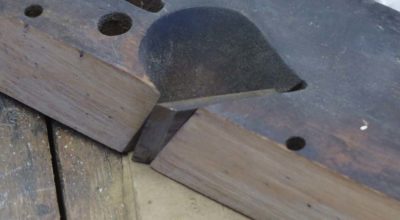
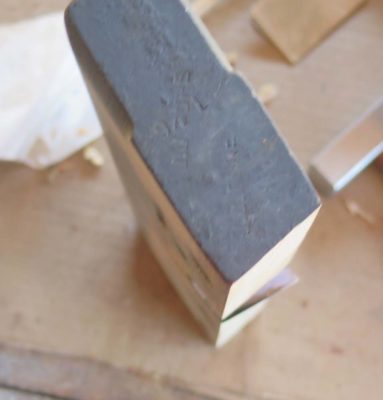
Once the new sole angle was established to match my dovetail gauge it was time to re-make an old iron to serve the intended purpose. Placing the old iron in the body showed how much steel needed to be removed to get the cutting iron and the sole angle to match each other.

I highlighted the iron with marker and shooting a line from the new sole surface against the un-beveled side of the iron with a carbide scribe I now knew how much steel to grind away.
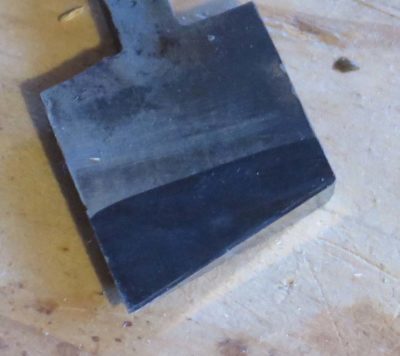
I ground the new line with no bevel to establish that line perfectly.
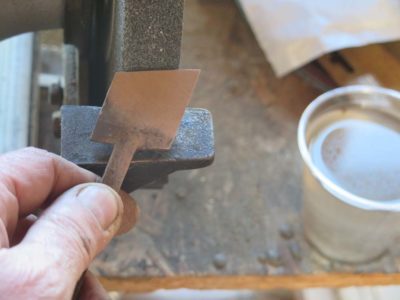

Once that was done I ground away most of the bevel on the power grinder and then finished it off by hand on my granite block and 60 grit abrasive belt.
I moved on to 120 grit and set the iron in place to assess the fit.

Perfectamundo.
Over the last few weeks I’ve been cleaning and organizing/reorganizing my studio, resulting in a more compact spatial scheme and, thus a space for my secret weapon in writing. Yup, I brought down my secret mojo into the studio to psyche me into attacking the completion of A Period Finisher’s Manual with gusto.
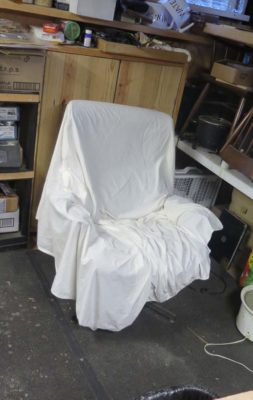
Sure, it is a raggedy third generation Eames knock-off (here draped in an old sheet to keep it clean-ish) but it is perhaps the most comfortable chair I’ve ever owned. It would be interesting to know the dimensions of Charles Eames’ physique because the chair fits me as though it had been custom-made for me. It’s sorta like a friend of mine, an armorer and devotee of Sig Sauer pistols, who tells me they fit him like a glove. Indeed S-S are superb precision tools, but the secret sauce to that recipe is that my friend is literally the hand model for the tool — of course he thinks they fit him perfectly, because they were designed to fit his own hand!
Anyway, I have already begun to work on revising the APFM manuscript with vengeance as I am simply tired of having it hanging over my head. Michele has advanced far ahead of me on the Roubo front so I need to get this one done and turn my attention to catching up with her.

I’m hoping this mojo works as well as in the past, when I could work expediently on a manuscript in my chair (even with cats draped allover me while I was revising Roubo 1).
Handworks is now six months away and we are busily preparing for stocking the booth for the onslaught of the thousands of friends old and new bound by the love of traditional hand woodworking tools.
My broom maker has a standing order for dozens of polissoirs to make sure I have plenty of these magical tools for show and sale. Unfortunately(?) I still get orders almost daily so building up the inventory is going slower than I would like. I go to the post office every week with a bag of packages to send.
The broom maker and his wife have finally moved into their dream house he has been building for the past several years, and is having trouble finding the time to set up his own workshop just the way he wants it. I spoke to him this morning (I had actually run out of the Model 296 polissoirs) and just yesterday he was able to begin using the workshop in the new house. I will be providing a complete set of polissoirs as a door prize for Handworks.

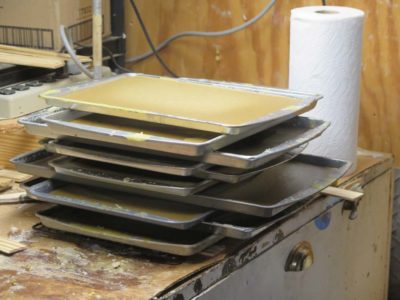
Here on the homestead I have been refining the raw beeswax, known in the apiary/honey/beeswax world as “slum gum”, to provide the purified raw material for Mrs. Barn to make into beeswax bars. There is nothing quite like the beautiful appearance of the amber nectar after the final filtering as I cast it out as molten material in cookie pans.

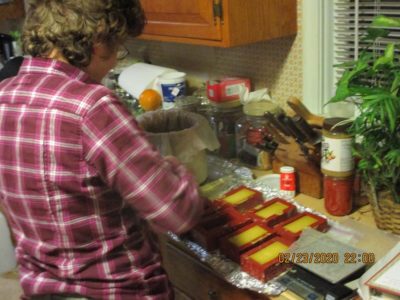
This is a favorite winter activity as it both heats the kitchen a little with her dedicated crockpot going almost 24/7 and imparts the lovely scent of clean molten beeswax throughout the cabin.

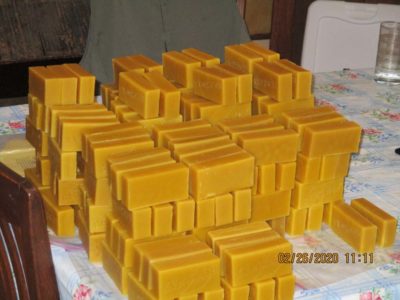

Over the days the pile of finished bars grows and grows, eventually becoming wrapped and placed in their storage boxes.
Meanwhile up in the Waxerie I’ve added casting more shellac wax and Blend 31 bars to my mix of activities. This is a nice punctuation to my other ongoing projects in the shop as it does not need my immediate attention all the time.
I plan to have a full inventory of polissoirs and waxes and stuff and will schedule hourly demonstrations at my booth at Handworks, and will expound on these as things come together.
This is not a “happy” bog post. It might be a little too much “inside baseball” but I thought you should know what is going on and what is coming down the pike. It’s probably bad form to discuss openly the costs of running a business, even a hobby one, and I will give that concern all the consideration I think it deserves. Okay, I’m done with that consideration.
It has been almost a decade since rediscovering the amazing surface prep and finishing tool called the polissoir, or polisher, and connecting up with a local craft broom maker to supply me with them. In that period I have sold and shipped thousands(!) of polissoirs and blocks of beeswax etc., and I hope to continue that success and match it with that of Mel’s Wax in the coming months and years. I delight in sharing the polissoir-and-beeswax’s almost magical qualities with the enthusiasts who have joined me in this trek taking a giant leap backwards in wood finishing. To encourage these tools’ adoption by the woodworking world I have kept the pricing stable almost since the beginning, folding the postage into the purchase price and keeping that unchanged since we went “official” with the Shop function on the website.
Unfortunately the postage increases implemented by the USPO over the past two years have affected me to the degree that, all by itself, postage now consumes over 15% of my gross sales revenue (and nearly 25% of the net), a nearly 100% increase in just the past year. This is so far out of whack I can hardly wrap my head around it, but the unavoidable result is that some of the heavier items in the Store will necessarily increase in price to reflect this grim reality as soon as we can edit the page.
(I am not griping about the post office, they provide excellent service to me and are convenient; I do not realistically have any other parcel carrier option out here in the hinterlands. I usually make the five-minute drive to our one-window post office in town once a week with a canvas tool bag full of parcels to mail. Making a three-hour round trip over the mountains to a parcel depot is not in the cards for me.)
To respond to this new cost reality, after long thought I’ve decided to raise the price of hand refined beeswax by $1 to $14, raising the Blend 31 to $17, and the shellac wax to $21.
All three models of the one-inch polissoirs will remain at their current price since they are so light weight and have apparently — thus far — remained below some postage threshold, but you never know with the USPS.
The large polissoirs, the two-inch woven-sheath and the Model 296 wrapped polissoirs, will be going from $47 to $49, and the two-pound bag of shellac flour will now be $75. Postage for Mel’s Wax is also 50% higher per unit than expected but I will leave that price alone for now as a strategic move.
I’m not apologizing for the increases: even though this is a labor of love for me I simply can’t keep selling and shipping products at the previous prices given the rising costs of postage. That is just a plain and simple fact whether I like it or not. I will be sad if these price increases diminish interest in polissoirs and waxes and such, but as the pundit says, “Facts don’t care about your feelings.”
And, given the recent disruptions in the bee hive health I am doubly glad I bought a lot of raw beeswax for us to hand-process into blocks and polishes just before the colony collapse crisis. I’m hoping that the raw material comes back down in price before I need to buy more at the end of this year, but at the moment the prices for beeswax are about double from when I bought some last.
Stay tuned and wish me luck.
A couple weeks ago while clearing out some stuff from my basement workshop at my daughter’s house, I came across an experiment that is almost forty years old.
In the world of historical fine art one of the premier positions is held by “panel paintings,” or fine paintings composed on a solid wooden panel. Given the age and prominence of these artworks, and the fact that they are unbalanced construction on an inherently unstable base given the presence of a precisely constructed laminar gesso and paint layer on the front side of the solid wood panel, caring for these artworks takes a high place in the preservation hierarchy. Very early in my museum career I found this problem to be a fascinating one, and the data points of my career projects (when I was able to choose the projects to work on, which was most of the time) revealed that it was the quality of the problem that motivated me much of the time, not necessarily the notoriety of the artwork/furniture. That explains my final project, which was the stabilization of a pair of wooden flag poles that encompassed a peculiar approach to addressing the problem of split timbers.
Back to panel paintings.

(Photo by H.L. Stokes via Wikipedia)
To counteract the unbalanced construction on a dynamic foundation, many, perhaps even most, ancient panel paintings have been augmented with a framework applied to the back side to both balance out the construction somewhat, but also to mitigate the tendency of the wood panel to warp. Sometimes these added features, called “cradles,” are elegantly sophisticated. Others are sophisticated and deleterious to the panel as the “floating” spines bind in the “pass through” blocks that are glued to the back side of the panel, inflicting new fractures to the panel along with the distortions as the panel attempts to expand and contract while the bound spines hold it in fixed dimensions, essentially a fixed cross-grain construction. This problematic outcome caused the entire concept to be reexamined beginning about the time I was coming into the museum world and many panel paintings have been de-cradled.
Shortly after hearing a seminar presentation on the topic in 1982 I decided to construct a prototype integrating my understanding of what wood is and how it behaves with some out-of-the-box thinking. Given that many of the old cradles were actually damaging the panel paintings, clearly a different approach was needed. Believe me, the number of alternatives to traditional cradling were legion, and even the last panel paintings conference I attended included several novel and unrelated options.

So I made a full scale model to test some ideas I had rattling around my brain pan. For starters I selected a less than premier piece of wood, it was literally a 2 x 12 resawn, planed, and glued together with hot hide glue into a “panel” approximately 20″ x 30″.

I then fabricated a series of “pass through” blocks with rounded contact points for the floating spines, which were themselves fairly lightweight, with the entire system glued to the back side of the panel.

You can see the construction of the blocks from this one that had been broken somewhere along the line. I applied spray dry Teflon to both the rounded faces of the blocks and the floating spines, hoping that the shape and permanent dry lubrication would prevent the blocks and spines from binding together (Teflon being the slipperiest substance on earth).

After assembling the entire model and showing it to the paintings conservators at the museum (I was working at Winterthur Museum at the time) I set it aside and literally forgot about it for almost four decades. Presumably it has been just sitting in the basement for all those years, responding to changes in the unregulated environment of the space. Over the life of the panel there have been swings in humidity from 100% to maybe 25%, more than enough to impart hysteresis cycles a’plenty.

Much to my delight the assemblage has suffered no ill effects over the decades, so at least the concept proved sound. The original construction is still perfectly flat and there are no instances of long-grain fracture to the wood. Admittedly the panel is balanced in that both faces are raw wood open to the microclimate so there was very little impetus for severe warpage. Still, I would have expected some loss in planarity if there was a flaw in the concept. Nope, still dead flat.
Now that I have reclaimed the experiment I will create a simple paint scheme on the face to mimic the structure of a typical Renaissance panel painting and see how the experimental cradled panel responds over the years. I will leave it sitting out of the way in the barn essentially exposed to the elements except for rain. I’ll check back with it in, say, another 38 years to see how it did. I’ll be 103 then, but I just got back from celebrating my Mom’s 103rd so that might not be too crazy.
If it still looks good then I’ll let someone in the museum world know about it.










































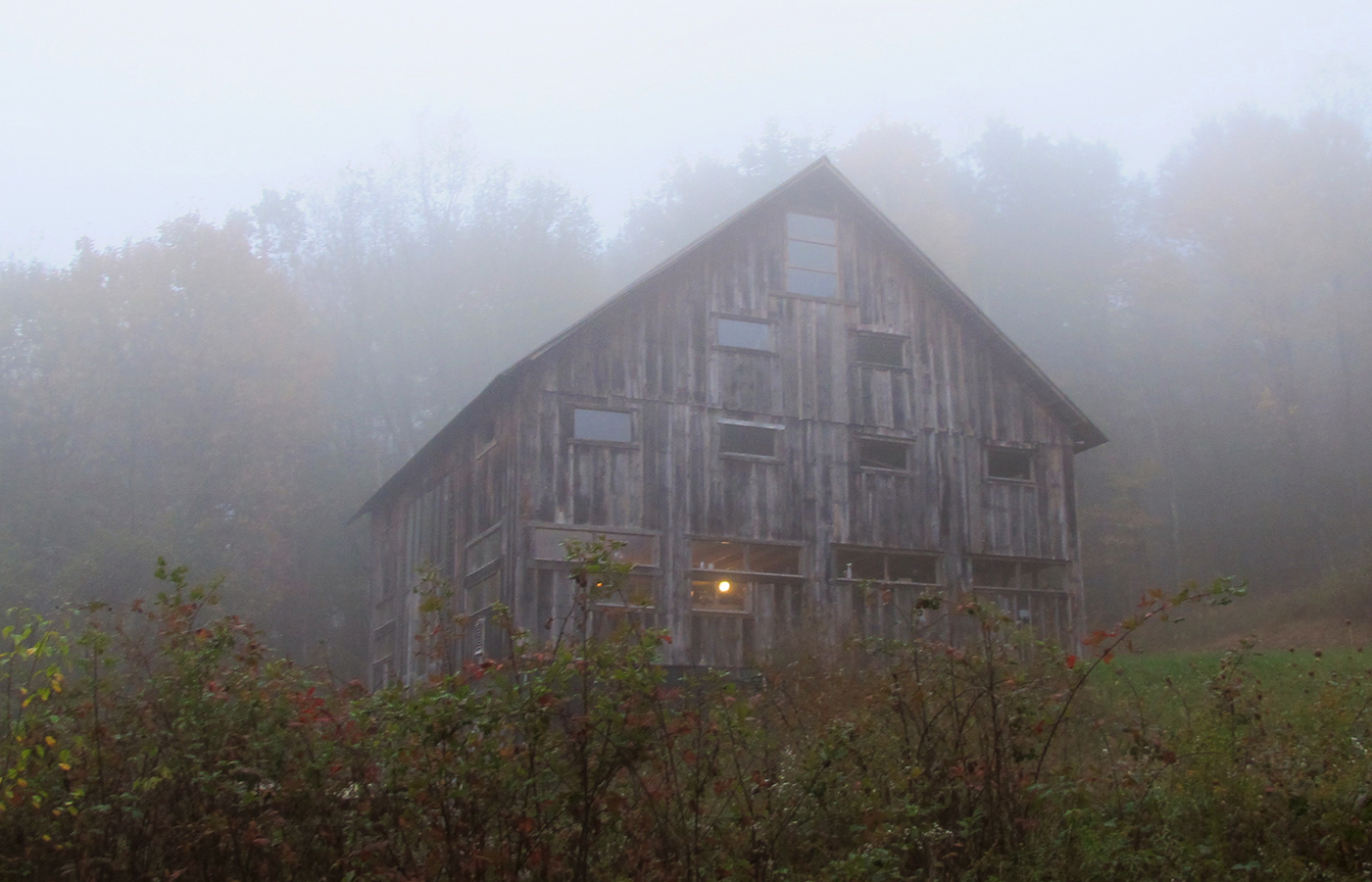
Recent Comments